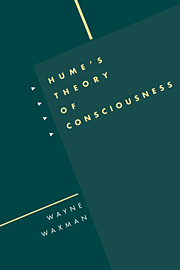Book contents
- Frontmatter
- Contents
- Preface
- Abbreviations
- Introduction: A false reason or none at all
- Part I The elements of Hume's philosophy
- Part II The cement of the universe
- Part III Vulgar fiction and philosophical fallacy
- 6 The true idea of the human mind
- 7 From mind to body
- Conclusion: The Cartesian nightmare come true
- Notes
- Bibliography
- Index
6 - The true idea of the human mind
Published online by Cambridge University Press: 11 September 2009
- Frontmatter
- Contents
- Preface
- Abbreviations
- Introduction: A false reason or none at all
- Part I The elements of Hume's philosophy
- Part II The cement of the universe
- Part III Vulgar fiction and philosophical fallacy
- 6 The true idea of the human mind
- 7 From mind to body
- Conclusion: The Cartesian nightmare come true
- Notes
- Bibliography
- Index
Summary
Perfect identity
When Hume speaks of identity, he means numerical identity – an object numerically the same with itself. Like any relation, identity entails comparison (see T13 and T73), and comparison is possible only given numerically different things to compare. Since numerical identity is impossible between the numerically different, this led Hume to situate the identity relation at a point (logically) posterior to the distinction between unity and number. Neither unity nor number is a relation, since they are presupposed by, not the result of, any comparison. Unity is the view of any object (perception), in so far as it is sufficient simply to convey an idea of it, but nothing more; it thus is as omnipresent an idea as that of existence (“That idea, conjoin'd with the idea of any object, makes no addition to it,” T66f.; cf. ECHU II/vii/§7). Since such a view necessarily precedes any operation of imagination which would distinguish the object as complex or simple within itself or relate it to something else without, the term “itself” in the statement “the object is the same with itself” merely repeats (i.e. is identical in content with) “object.” Number, on the other hand, is the concurrence of several views, and yields only diversity, but not yet relation; it is merely the prerequisite for the comparison or association by which diverse perceptions are separated or related in imagination.
- Type
- Chapter
- Information
- Hume's Theory of Consciousness , pp. 203 - 237Publisher: Cambridge University PressPrint publication year: 1994
- 1
- Cited by



